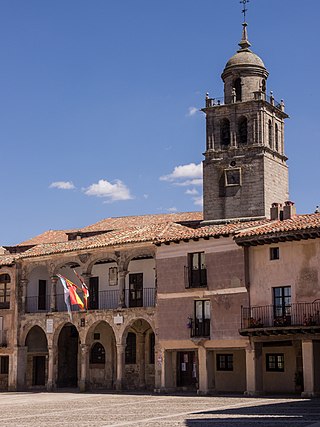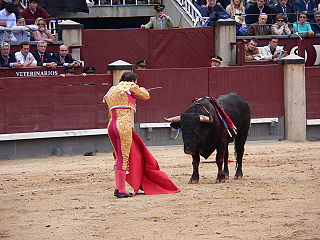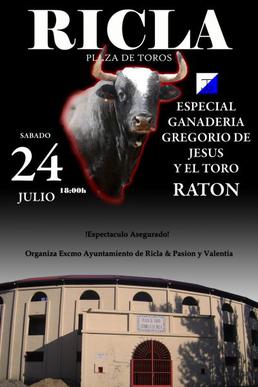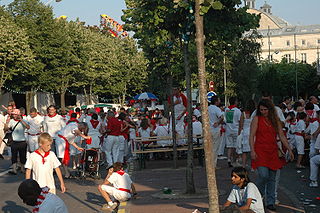
The Fallas is a traditional celebration held annually in commemoration of Saint Joseph in the city of Valencia, Spain. The five main days celebrated are from 15 to 19 March, while the Mascletà, a pyrotechnic spectacle of firecracker detonation, takes place every day from 1 to 19 March. The term Fallas refers to both the celebration and the Falla monuments burnt during the celebration. A number of towns in the Valencian Community have similar celebrations inspired by the original Fallas de Valencia celebration. For example, the bonfires of Alicante or the Fiestas de la Magdalena in Castellón de la Plana. The Fallas festival was added to UNESCO's intangible cultural heritage of humanity list on 30 November 2016.
La Tomatina is a Spanish festival in Buñol, Spain where participants throw tomatoes at each other. It is said to be the biggest food fight in the world. From the festival's origin as a food fight between friends in the 1940s, it has become a famous tourist attraction. Previous to 2013, the festival did not operate with an upper cap on the number of attendees which would cause a strain on Buñol's population of about 9,000 inhabitants. Since 2013, however, the festival has a ticketed event with a capacity of 20,000 participants.

The festival of San Fermín is a week-long, historically rooted celebration held annually in the city of Pamplona, Navarre, Spain. The celebrations start at noon on 6 July and continue until midnight on 14 July. A firework (Chupinazo) starts off the celebrations and the popular song Pobre de mí is sung at the end. The most famous event is the running of the bulls, which begins at 8 a.m. each day on 7–14 July, but the festival involves many other traditional and folkloric events. It is known locally as Sanfermines in Spanish and Sanferminak in Basque, and is held in honour of Saint Fermin, the co-patron of Navarre.

A running of the bulls is an event that involves running in front of a small group of bulls, typically six but sometimes ten or more, that have been let loose on sectioned-off streets in a town, usually as part of a summertime festival. Particular breeds of cattle may be favored, such as the toro bravo in Spain, also often used in post-run bullfighting, and Camargue cattle in Occitan France, which are not fought. Bulls are typically used in such events.

Apurímac is a department and region in southern-central Peru. It is bordered on the east by the Cusco Region, on the west by the Ayacucho Region, and on the south by the Arequipa and Ayacucho regions. The region's name originates from the Quechua language and means "where the gods speak" in reference to the many mountains of the region that seem to be talking to each other.
In Spanish-speaking cultures, a verbena is an agricultural show, modest amusement park, or dance party, especially one held at night. An old tradition, they usually take place after dark in summer. Nowadays, some major cities, such as Barcelona, host "permanent" verbenas, but these have less tradition character than those that appear for only a few days each year.

Correfocs ; literally in English "fire-runs") are among the most striking features present in Valencian and Catalan festivals. In the correfoc, a group of individuals will dress as devils and light up fireworks – fixed on devil's pitchforks or strung above the route. Dancing to the sound of a rhythmic drum group, they set off their fireworks among crowds of spectators. The spectators that participate dress to protect themselves against small burns and attempt to get as close as possible to the devils, running with the fire. Other spectators will watch from "safe" distances, rapidly retreating as necessary.

Medinaceli is a municipality and town in the province of Soria, in Castile and León, Spain. The municipality includes other villages like Torralba del Moral.

Spanish-style bullfighting is a type of bullfighting that is practiced in Spanish-speaking countries: Spain, Mexico, Colombia, Ecuador, Venezuela, Peru, as well as in parts of southern France and Portugal. This style of bullfighting involves a physical contest with humans attempting to publicly subdue, immobilize, or kill a bull. The most common bull used is the Spanish Fighting Bull, a type of cattle native to the Iberian Peninsula. This style of bullfighting is seen to be both a sport and performance art. The red colour of the cape is a matter of tradition – bulls are color blind. They attack moving objects; the brightly-colored cape is used to mask blood stains.

San Sebastián, officially known by the bilingual name Donostia / San Sebastián, is a city and municipality located in the Basque Autonomous Community, Spain. It lies on the coast of the Bay of Biscay, 20 km from the France–Spain border. The capital city of the province of Gipuzkoa, the municipality's population is 188,102 as of 2021, with its metropolitan area reaching 436,500 in 2010. Locals call themselves donostiarra (singular), both in Spanish and Basque. It is also a part of Basque Eurocity Bayonne-San Sebastián.
Benacazón is a city located in the comarca of Aljarafe, in the province of Seville, southern Spain.
The Donostia Award is an honorary award created in 1986 which is given every year to a number of actors and filmmakers in the San Sebastián International Film Festival. It derives its name from Donostia, the Basque name of San Sebastián.

Bullfighting is a physical contest that involves a bullfighter attempting to subdue, immobilize, or kill a bull, usually according to a set of rules, guidelines, or cultural expectations.

Ratón was a Spanish fighting bull that was nicknamed el toro asesino, el sangriento toro Raton and el terrible Ratón for killing three people in bullfighting rings in Spain during 2006–2011 and injuring thirty more. The bull became legendary in Spain due to the large number of gorings for which he was responsible. Bullfighting fans regarded him as a star and traveled from across the country to see the morlaco at his home at Sueca near Valencia. Matador Jesús Esteve said of Ratón: "He is a killer. He is lazy, he doesn't want to participate. He does his own thing, waiting for somebody to make a mistake. And then when he gets you, he wallops you, and he doesn't let up."

A toro embolado, bou embolat, roughly meaning 'bull with balls', is a festive activity, typical of many towns in Spain, in which a bull that has burning balls of flammable material attached to its horns is set free in the streets at night, and participants dodge the bull when it comes close. It can be considered a variant of an encierro. This activity is held in a number of Spanish towns during their local festivals. In the 21st century animal welfare activists have attempted to stop this practice as cruel.

Mexican handcrafted fireworks production is mostly concentrated in the State of Mexico in central Mexico. The self-declared fireworks capital of Mexico is Tultepec, just north of Mexico City. Although the main ingredient for fireworks, gunpowder, was brought by the conquistadors in the 16th century, fireworks became popular in Mexico in the 19th century. Today, it is Latin America’s second largest producer, almost entirely for domestic use, with products ranging from small firecrackers to large shells and frames for pyrotechnics called “castillos” (castles) and “toritos”. The industry is artisanal, with production concentrated in family-owned workshops and small factories with a number operating illegally. The relatively informal production and sales of fireworks have made it dangerous with a number of notable accidents in from the late 1990s to the present, despite attempts to safety regulations.

A feria is an annual local festival in Spain and southern France, characterized by bullfights, bull running in the streets, bodegas and bandas. The word festayre means ferias' partiers.

The National Pyrotechnic Festival, which takes place in Mexico, is an annual event to promote the country's tradition of production and use of fireworks. It began as celebration in honor of John of God, the patron saint of fireworks makers, in the municipality of Tultepec, State of Mexico, which produces about three quarters of all Mexico’s fireworks. The main event, a parade of toritos—or bull-shaped frames with fireworks attached to them—began in the mid 19th century. The modern national festival began in 1989 and consists of various events, including fireworks competitions. However, the main event remains that of the toritos; about 250 of which were paraded along the streets of Tultepec during the 2013 festival.

Aste Nagusia or "The Great Week" is the main festival of Bilbao, Basque Country, Spain, which is celebrated annually over 9 days beginning on the first Saturday following 15 August, the festivity of the Assumption of Our Lady.

Amarapedia is a collaborative project linking the quarter of Amara in Donostia-San Sebastián and the on-line encyclopaedia Wikipedia, which is focused on the facilities of local information system, covering subjects such as places, buildings, facilities, and streets. Amarapedia is inspired by the Welsh experience of Monmouthpedia and it was a pilot project for future larger-scale projects that took place in the city of Donostia-San Sebastián in 2016, when the city was the European Capital of Culture.

![Wheelbarrow rockets [es; ca] Carretilla u.JPG](http://upload.wikimedia.org/wikipedia/commons/thumb/f/f8/Carretilla_u.JPG/220px-Carretilla_u.JPG)


















